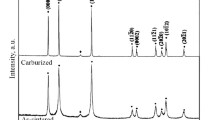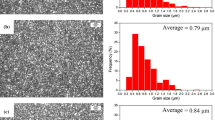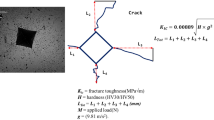Abstract
Functionally graded or functionally gradient WC–Co cemented carbides with Co and/or hardness gradients can potentially have great practical importance. In this article is described a novel sintering technique for fabrication of functionally gradient WC–Co cemented carbides. This technique includes (1) employing green carbide bodies with low (or high) carbon contents within the two-phase region of the W–Co–C phase diagram; (2) their pre-sintering in the solid state to obtain a certain green density and consequently gas permeability; (3) selective carburisation (or decarburisation) of their surface layer in a carburising (or decarburising) gas atmosphere; and (4) final liquid-phase sintering at tailored sintering conditions to obtain a Co drift (also known as ‘Co migration’) either from the surface towards the core or from the core towards the surface. The kinetics of Co drift between couples of model alloys with very similar WC mean grain sizes but different carbon contents were examined. The microstructure, hardness, Co contents, residual stresses and wear-resistance of the gradient cemented carbides with low-Co surface layers obtained by the selective surface carburisation of carbide green bodies with the original low carbon content were examined. Their surface layers were found to contain significantly less Co than the core resulting in a higher hardness of the surface layer. The surface layer is also characterised by high residual compressive stresses in both the carbide phase and binder phase, which results in an improved combination of hardness and fracture toughness. The microstructure, hardness and Co contents of gradient cemented carbide comprising high-Co surface layers obtained by selective surface decarburisation of carbide bodies with the original high carbon content were also examined. The surface layer of the gradient cemented carbide contains noticeably more Co than the core which is beneficial when using this functionally gradient carbide as a substrate for polycrystalline diamond coatings.

















Similar content being viewed by others
References
Aronsson B, Hartzell T, Aakerman J (1988) In: Proceedings of advances in hard materials production conference. MPR Publ. Serv. Ltd, Shrewsbury, p 19/1
Fischer U, Hartzell E, Akerman J (1988) Cemented carbide body used preferably for rock drilling and mineral cutting. US Patent 4,743,515
Zhang L, Wang Y, Yu X, Chen S, Xiong X (2008) Int J Refract Met Hard Mater 26:295
Liu Y, Wang HM, Long Z, Liaw P, Yang J, Huang B (2006) Mater Sci Eng A 426:346
Liu Y, Wang H, Yang J, Huang B, Long Z (2004) J Mater Sci 39:4397. doi:10.1023/B:JMSC.0000033437.75050.5d
Colin C, Durant L, Favrot N (1993–1994) Int J Refract Met Hard Mater 12:145
Rassbach S, Moseley S, Böhlke W (2009) In: Sigl L, Rödhammer P, Wildner H (eds) Proceedings of the 17th international Plansee seminar, 2009, vol 2. Plansee Group, Reutte, p 48/1
Collin M, Norgren S (2008) Cemented carbide insert and method of making the same. European Patent EP1548136B1
Glatzle J, Kosters R, Glatzle W (2004) Hard metal component with a graduated structure and methods of producing the component. US Patent Application US2004/0009088
Greenfield M (1997) Sintered hard-alloy composites and tools manufactured with microstructural zones by grain refining. US Patent 5,623,723
Eso O, Fang Z, Griffo A (2005) Int J Refract Met Hard Mater 23:233
Eso O, Fang P, Fang Z (2007) Int J Refract Met Hard Mater 25:286
Fang Z, Fan P, Guo J (2010) Functionally graded cemented carbide with engineered hard surface and the methods for making the same. US Patent Application US2010/0101368A1
Guo J, Wang F (2010) Advanced in powder metallurgy and particulate materials. Metal Powder Industries Federation, Washington, p 8/29
Guo J, Fan P, Fang Z (2009) In: Sigl L, Rödhammer P, Wildner H (eds) Proceedings of the 17th international Plansee seminar, vol 2. Plansee Group, Reutte, p 50/1
Bellin F, Dourface A, King W, Thigpen M (2010) World Oil Nov. 2010:67
Mukhopadhyay DK, Bertagnolli KE (2009) In: Sigl L, Rödhammer P, Wildner H (eds) Proceedings of the 17th international Plansee seminar, vol 2. Plansee Group, Reutte, p 31/1
Sorlier E, Colin C (2009) In: Sigl L, Rödhammer P, Wildner H (eds) Proceedings of the 17th international Plansee seminar, vol 2. Plansee Group, Reutte, p 7/1
Konyashin I, Hlawatschek S, Ries B, Lachmann F, Sologubenko A, Weirich T (2010) Int J Refract Met Hard Mater 28:228
Konyashin I, Hlawatschek S, Ries B, Lachmann F (2010) A hard-metal body. PCT Patent Application WO2010/097784A1
Konyashin I, Hlawatschek S, Ries B, Lachmann F (2010) A superhard element, a tool comprising same and methods for make such superhard element. PCT Patent Application WO2010/103418A1
Konyashin I, Hlawatschek S, Ries B, Lachmann F (2009) In: Sigl L, Rödhammer P, Wildner H (eds) Proceedings of the 17th international Plansee seminar, vol 2. Plansee Group, Reutte, p 6/1
Konyashin I, Hlawatschek S, Ries B, Lachmann F, Weirich T, Dorn F, Sologubenko A (2009) Int J Refract Met Hard Mater 27:234
Roebuck B, Gee MG, Morrell R (2001) In: Kneringer G, Rödhammer P, Wildner H (eds) Proceedings of the 15th international Plansee seminar, vol 4, Reutte, p 245
Mari D, Claussen B, Bourke MAM, Buss K (2009) Int J Refract Met Hard Mater 27:282
Krawitz AD, Venter AM, Drake EF, Luyckx SB, Clausen B (2009) Int J Refract Met Hard Mater 27:313
Coats DI, Krawitz AD (2003) Mater Sci Eng A359:338
Fitzpatrick M, Fry T, Holdway P et al (2005) NPL good practice guide no. 52: determination of residual stresses by X-ray diffraction—Issue 2. NPL, Great Britain
Author information
Authors and Affiliations
Corresponding author
Rights and permissions
About this article
Cite this article
Konyashin, I., Ries, B., Lachmann, F. et al. A novel sintering technique for fabrication of functionally gradient WC–Co cemented carbides. J Mater Sci 47, 7072–7084 (2012). https://doi.org/10.1007/s10853-012-6516-x
Received:
Accepted:
Published:
Issue Date:
DOI: https://doi.org/10.1007/s10853-012-6516-x




